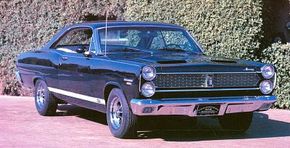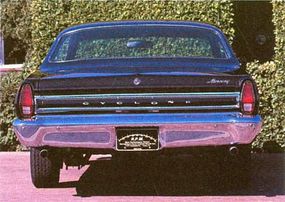When the 1966-1967 Mercury Cyclone GT entered the market, it was a different breed of Comet -- and a different breed of performance-packed Cyclone. Because Ford and Mercury models were now so closely related, a body change at Ford invariably affected Mercury's side of the street, too.
Since its introduction in 1960, Mercury's Comet was always somewhat larger than the Ford Falcon on which it was based, though smaller than the intermediate Ford Fairlane introduced in 1962. By 1966, however, it was apparently decided that the expense of producing three different "small" bodies wasn't justified, so Ford Motor Company followed GM's lead by "cloning" its intermediates, moving the Comet up to share the newly redesigned Fairlane's 116-inch wheelbase.
Advertisement
Four Comet subseries comprised the new lineup: budget-priced (and shorter) 202, plus a Capri, Caliente, and Cyclone, the last three stretching to 203 inches in length. Wheelbases measured 116 inches on all, up from 114.
As in its prior incarnation under the Comet Cyclone banner, the bigger (maybe even better) new Mercury Cyclone came in just two body styles -- hardtop coupe and convertible -- in either base or GT form.
The 1966 Mercury Cyclone GT had only one engine choice: a 335-bhp, 390-cid V-8 with four-barrel carburetor and dual exhausts. Sound familiar? Fairlane GTs used the same engine. Mercury ads promised that their GT "delivers go that can shove you right back into your bucket seat."
Suspensions earned an upgrade, but obviously the big change was in the body. All Cyclones wore vertically stacked quad headlights recessed into separate round housings, dual pinstripes, and a twin-section grille.
Dramatic lower-body race striping between the wheel openings, a checkered-flag front-fender insignia, and a pair of flat hood scoops (which led nowhere) were part of the 1966 Mercury Cyclone GT package.
Though similar in shape to the regular Comet/Cyclone grille, the GT version had its own pattern of horizontal bars, plus a tiny checkerboard segment on one end. Two thin full-length stripes ran along the upper fender line. Not everyone realized it, but the GT's hood was made of fiberglass.
The 1966 Mercury Cyclone GT also included an engine dress-up kit, 7.75 x 14 whitewalls on heavy-duty 5.5-inch wheels, 3.25:1 axle ratio, and console-mounted gearshift lever.
The heavy-duty suspension used a large-diameter front stabilizer bar. Bucket seats were upholstered with pleated vinyl, available in solid colors or two-tone mixtures. The driver faced a sports-style two-spoke steering wheel, a raised group of instruments, and black matte dashboard.
Either a four-speed manual or Sport Shift Merc-O-Matic could replace the standard three-speed. Sport Shift permitted manual control of 1-2-3 shift points, or easy cruising in Drive range.
Since the loss of the Meteor after 1963, Mercury had no mid-size model at all; so the enlarged Comet-derived series appealed to a fresh set of customers. Mercury Cyclone GTs outsold regular Cyclones by almost 2-to-l, with 15,970 reaching the showrooms. Even so, the cheaper Comets scored higher, led by the low-budget 202 series with nearly 64,000 coming off the line.
See what happened with the 1967 Mercury Cyclone GT on the next page.
For more information on cars, see:
- Classic Cars
- Muscle Cars
- Sports Cars
- Consumer Guide New Car Search
- Consumer Guide Used Car Search
Advertisement



